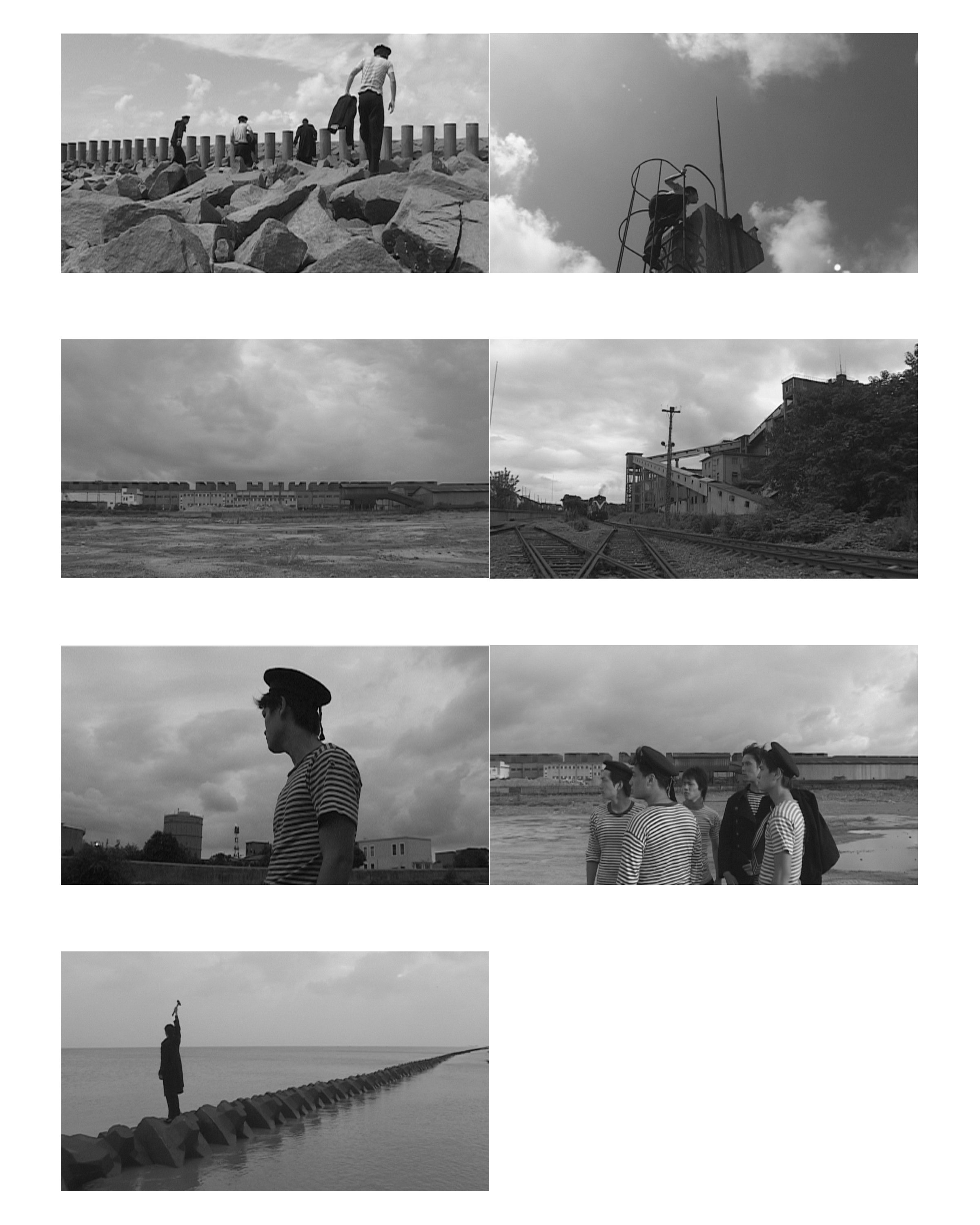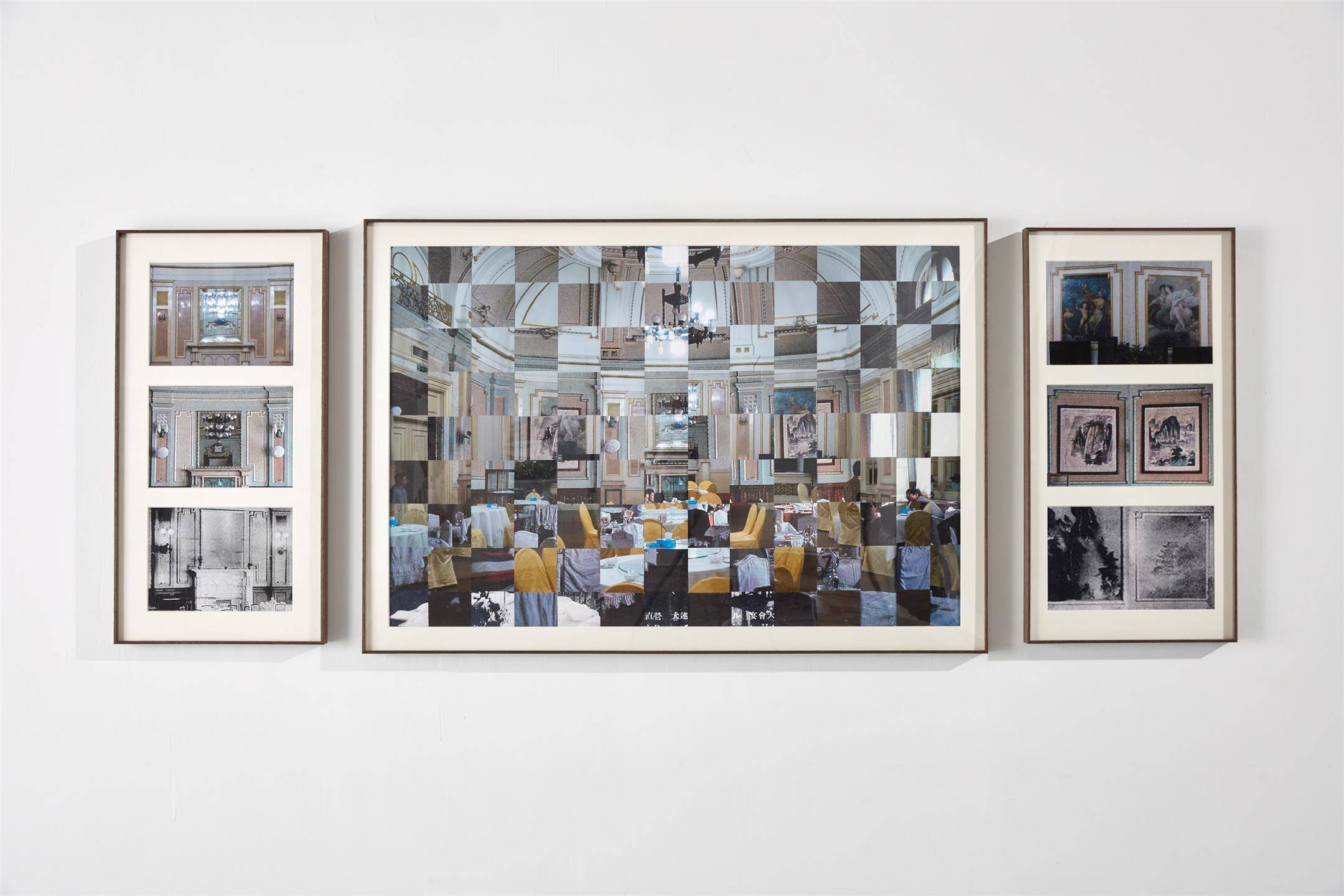
© » KADIST
Lu Yang
Advanced Technology (Advanced Technology)
The Great Adventure of the Material World Knight by Lu Yang is a video game world in which an androgynous protagonist goes on a hero’s journey to overcome their understanding of the material world as a coherent, objective truth. Looping arcade music builds suspense as the artist mobilizes varying aesthetics—Sinofuturist cityscapes, Kawaii, religious imagery, anime characters, and body scans of the artist—to propel the viewer through a series of levels, including heaven, hell, and various sites populated by deities and monsters. While traversing these worlds, the protagonist encounters a dizzying array of characters while posing a series of questions about the subjective nature of reality, desire, and suffering.

© » KADIST
Lu Chunsheng
Lu has developed an oeuvre that consists of characters in bizarre situations. The large-scale photograph I Want to Be a Gentleman depicts nine men standing like statues on display in a museum on tall plinths in front of a run-down industrial building. Lu’s brooding films and photographs are preoccupied with China’s industrial era and communist history.

© » KADIST
Fang Lu
No World is an action-filled video work filmed inside an abandoned museum in the Songzhuang area outside Beijing. Without using any dialogue, Lu created an artificial scenario where she instructed actors with a list of tasks to gesturally mime scenes from news and journalistic images outside China. Through an intuitive self-trained mimicry, these acts simultaneously became moves in a game as well as a daily routine.

© » KADIST
Fang Lu
Canton Novelty by Fang Lu captures the adventure of a group of three girls, Ruohan, Lily and Zoe on a summer vacation in Guangzhou, China. Throughout the course of the trip, they film themselves with their cell phones singing in a karaoke room, shopping at a hardware store, sitting at a park, hanging out in a hotel room and exploring a neighborhood looking at vacant apartment ads. Although their days may seem uneventful, the girls seemingly discover the ability to perform impossible “miracles,” including cooking a full pot of rice from three grains, summoning objects to appear and disappear, and turning off street lamps on command.

© » KADIST
Haegue Yang
In addition to Yang’s signature drying rack and light bulbs, Office Voodoo includes various office supplies like CDs, paper clips, headphones, a computer mouse, a stamp, a hole puncher, a mobile phone charger. The installation suggests the personal, physical, psychological, and political dimensions of the modern office environment. Though abstracted from their original contexts, these materials are still formally recognizable and function as stand-ins for the places from which they came.

© » KADIST
Yang Guangnan
In Action no. 1 Yang Guangnan reflects on the interiority and exteriority of human-technological experience with mechanical gestures that are semi-human and semi-machine. A hanged shirt mounted upon the artist’s machine rhythmically bounces and rotates in a way that suggests a skeletal interior.

© » KADIST
Lu Pingyuan
Masterpiece in the Water by Lu Pingyuan tells the story of an impatient collector who is killed by an artist. This murder becomes an artwork in of itself as the story within the story sheds light on the psychological anxieties faced by soldiers during war time, the family bond, and the paranormal. This playful, yet violent, story explores the amusing similarity between supernatural events and the creation of artistic ideas, while reflecting on the complex relationships that exist within the art world.

© » KADIST
Lu Chunsheng
A mesmerizing experience of a vaguely familiar yet remote world, History of Chemistry I follows a group of men as they wander from somewhere beyond the edge of the sea through a vast landscape to an abandoned steel factory. Using long shots and atypical settings, Lu Chunsheng enigmatically refers to a distant history while conveying the sense of dislocation wrought by successive stages of modernization. The combination of elaborate landscape shots from the suburbs of Shanghai and Lu’s signature style of spare and minimally crafted acting offers a surreal view of human behavior in spaces marked by the hulking remnants of China’s extraordinary development.

© » KADIST
Fang Lu
In the work Cinema , Fang Lu explores in a meticulous yet un-dramatic — almost casual — way of how “the self” in our today’s life is a controlled and staged construction of oneself. What appears at first sight to be a not unusual performance of self-choreography, becomes at a second glance a disturbing portrait of a – female – persona brought to life under contemporary conditions of attractiveness, anxiety and narcissism. Unlike her previous works, which duel more on the internal, surrealistic human conditions, this seven-channel work elevates the individual relationship with its socio-political environment to a more recognizable and appealing set of behavioral actions of self-awareness and self-inflicted anguish.

© » KADIST
Yang Song
Yang Song’s Die features a clay mask of the artist himself slowly dissolving into water. Clay returns to clay. Clay originates from and returns to earth, becoming a metaphor for life.

© » KADIST
Yang Xinguang
Although seemingly unadorned at first glance, Yang Xinguang’s sculptural work Phenomena (2009) employs minimalist aesthetics as a means of gesturing towards the various commonalities and conflicts between civilization and the natural world. Comprised of rudimentary planks of wood hammered together into a rectangular form, Yang’s work uses reclaimed materials from everyday life and seems deliberately in conversation with Arte Povera, the art movement that originated in Italy during the late 1960s where practitioners produced art from found and common materials as an act of resistance against the decided commercialization of the art world through market economies. Yang, by extension, pays close attention to his materials in attempt to release the forms within them rather than impose his own.

© » KADIST
Yang Guangnan
Itch explores the relationship between technology and daily human experience with a motorized arm that extends from within the gallery’s wall, moving up and down while holding a projector that shows a desperately scratching pair of hands.

© » KADIST
Yang Zhenzhong
Peasant Sensation Passing Through Flesh – 3 consists of a massage chair fixed to a wall. With its cushions removed to reveal its internal mechanisms, the chair’s programmed rubbing, kneading, patting, and vibrating motions create a strange sight and soundscape. The work explores the relationship between flesh and machine as they come together through technologically simulated social behaviors, challenging normative ideas about human interaction.

© » KADIST
Haegue Yang
A steel clothing rack adorned with turbine vents, Moroccan vintage jewelry, pinecones and knitting yarn, these heterogeneous elements are used here to create an exotic yet undefined identity within the work. Following Haegue Yang’s 2010 anthropomorphic series Medicine Men, this sculpture appears as a shamanic objet or being. It is mobile and can be activated.

© » KADIST
Luka Yuanyuan Yang
Composed of three photographic panels, Three Times at Yamato Hotel by Luka Yuanyuan Yang is a part of the artist’s ongoing project Dalian Mirage , a seven act play in a theatre staged as the city of Dalian. This modern city was built by the Russian Empire in 1898 and occupied by Japan between 1905 and 1945. Based on historical investigations, Yang created ten characters, including a Dalian-born Japanese writer and a Dalian-born American immigrant.
Fang Lu
Fang Lu uses intimacy as a place for self-expression in her videos and draws out mundane moments from everyday life as a strategy to heighten one’s awareness of existence from the rest of the world...
Lu Chunsheng
- location: Shanghai, China
- year born: 1968
- gender: male
- nationality: Chinese
- home town: Changchun, Jilin province, China
Yang Guangnan
- location: New York City, United States
- year born: 1986
- home town: Inner Mongolia, China
Haegue Yang
- location: Berlin, Germany & Seoul, South Korea
- year born: 1971
- gender: female
- nationality: Korean
- home town: Seoul, South Korea
Lu Yang
Through an aesthetic steeped in manga and Final Fantasy, Lu Yang’s work uses the rubric of role-playing video games to model the possibility of liberation from repressive gender roles and societal norms, given compelling form through kinetic action and AAA-level video game graphics...
Luka Yuanyuan Yang
Luka Yuanyuan Yang is a photographer, filmmaker and visual artist based in Beijing...
Yang Xinguang
- location: Beijing, China
- year born: 1980
- gender: male
- nationality: Chinese
- home town: Hunan Province, China
Yang Zhenzhong
- location: Shanghai, China
- year born: 1968
- gender: male
- nationality: Chinese
- home town: Xiaoshan, China
Yang Song
Yang Song was trained as a sculptor in both Western and Eastern traditions, which continue to influence his practice today...
Lu Pingyuan
Lu Pingyuan works with a variety of media such as texts, videos, installations, paintings, performances and other...
-
2000-2009
Lu Chunsheng
2004A mesmerizing experience of a vaguely familiar yet remote world, History of Chemistry I follows a group of men as they wander from somewhere beyond the edge of the sea through a vast landscape to an abandoned steel factory...
Yang Xinguang
2009Although seemingly unadorned at first glance, Yang Xinguang’s sculptural work Phenomena (2009) employs minimalist aesthetics as a means of gesturing towards the various commonalities and conflicts between civilization and the natural world...
-
2010-2019
Haegue Yang
2010In addition to Yang’s signature drying rack and light bulbs, Office Voodoo includes various office supplies like CDs, paper clips, headphones, a computer mouse, a stamp, a hole puncher, a mobile phone charger...
Yang Guangnan
2011Itch explores the relationship between technology and daily human experience with a motorized arm that extends from within the gallery’s wall, moving up and down while holding a projector that shows a desperately scratching pair of hands....
Yang Zhenzhong
2012Peasant Sensation Passing Through Flesh – 3 consists of a massage chair fixed to a wall...
Lu Pingyuan
2016Masterpiece in the Water by Lu Pingyuan tells the story of an impatient collector who is killed by an artist...
Haegue Yang
2016A steel clothing rack adorned with turbine vents, Moroccan vintage jewelry, pinecones and knitting yarn, these heterogeneous elements are used here to create an exotic yet undefined identity within the work...
Luka Yuanyuan Yang
2019Composed of three photographic panels, Three Times at Yamato Hotel by Luka Yuanyuan Yang is a part of the artist’s ongoing project Dalian Mirage , a seven act play in a theatre staged as the city of Dalian...
-
2020-2029
Lu Yang
Advanced Technology
2021(Advanced Technology) The Great Adventure of the Material World Knight by Lu Yang is a video game world in which an androgynous protagonist goes on a hero’s journey to overcome their understanding of the material world as a coherent, objective truth...